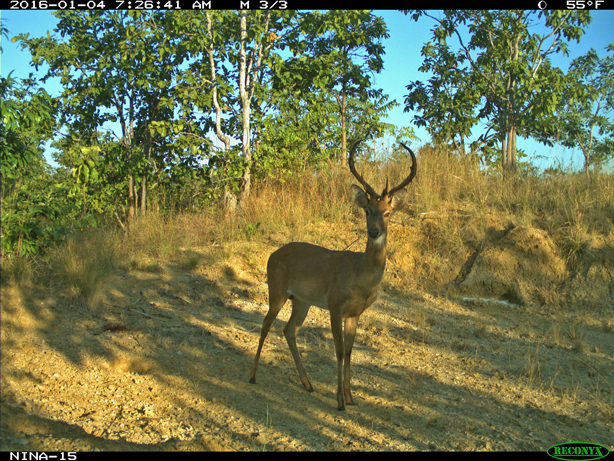Developing state-of-the-art statistical tools that combine different sources of data has allowed researchers from Norway and Myanmar to make robust estimates of population size for an often-overlooked population of one of the world’s most threatened deer species. The results of the analysis indicate that the population of thamin, or Eld’s deer, in Myanmar’s Shwesettaw Wildlife Sanctuary is currently around 1500 individuals, making it by far the largest population of this species anywhere in the world.
Den gylne hjorten, også kjent som Elds hjort, en av verdens mest utrydningstruede hjortedyr-arter. Foto: John Linnell / NINA.
For a rare species Eld’s deer has many names! Variously known as thamin, golden deer or brow-antlered deer (Rucervus eldii in latin) the species is native to eastern India, Myanmar, Thailand, Cambodia, Laos, Vietnam and parts of China. The species has been exterminated from almost all its former distribution, only persisting in the wild in one swamp in India, a few scattered populations in Myanmar, Laos and Cambodia, and on a Chinese island. The IUCN classify it as “Endangered”. Myanmar has long been known for hosting two of the largest surviving populations in Chatthin and Shwesettaw wildlife sanctuaries. In recent decades most conservation attention has been focused on the Chatthin population which was the largest of the two. Unfortunately, this has dramatically declined in recent years. In the meantime, the population in Shwessettaw has increased slowly but steadily.
Now that the Shwessettaw population appears to be the largest surviving population it became urgent to find out how many animals made up the population. The population had been regularly monitored for over 20 years using a method that has allowed the sanctuary staff to follow relative trends, but which was not ideal to determine exactly how large the populations was. The staff had been conducting counts along transects that they walked every year in the eastern part of the sanctuary, but it was unknown how much of the landscape was used by the deer in areas that were not covered by the transects. To explore this, the researchers made use of intensive camera trapping surveys conducted across the whole sanctuary in 2014 and 2016. Integrating this data on distribution with the transect data on density allowed the researchers to come up with a robust estimate for the total size of the population.
The result of the analysis indicated a total population size of 1500 Eld’s deer. Interestingly, the animals are mostly concentrated in the northeast part of the study area during the dry season (when the surveys were conducted). This area largely consists of a military base and military cotton plantation. It appears that Eld’s deer have benefited from the increased protection from poaching, and the increased access to water and open habitats within the military controlled area. Human pressure on the rest of the wildlife sanctuary is very high, with illegal clearance of forest for agriculture, snaring for wildlife, charcoal production, electric-fishing and timber harvest.
Project leader, John Linnell at the Norwegian Institute for Nature Research (NINA) explains “This study is really good news for this highly endangered species. For many years the rangers and staff of Shwessetaw have done their best to protect these deer and their habitat against human impacts with almost no resources. Their efforts have been largely unknown and under-appreciated. We hope that this confirmation of the global importance of this site for Eld’s deer will now bring them greater recognition and resources”.
The result is also encouraging for the conservation of the species. “The persistence and recent growth of this population gives hope for the conservation of the species. It shows that they can tolerate a fairly high degree of human impact on the landscape, like in the military cotton plantation, as long as they are protected from poaching. However, there will need to be a dramatic increase in law enforcement in the rest of the sanctuary because we routinely encountered snares set for deer while we were doing fieldwork” says John Linnell.
Erlend B. Nilsen, senior researcher at the Norwegian Institute for Nature Research (NINA) and co-author of the study underlines the importance of the new statistical method developed in this study: “From most regions of the world, there is a lack of standardized monitoring programs at a spatial scale sufficient for conservation and policy needs. Often, what we have is spatially limited data from monitoring of population abundance combined with information about species distribution. Therefore, methods that can be used to formally combine these sources of data to estimate the size of wildlife population are extremely valuable. We expect such methods to be applied more and more often in the future when assessing the status of species”


Camera trap images / NINA
The study was published in Scientific Reports and was conducted by the Norwegian Institute for Nature Research, the Norwegian University of Life Sciences (NMBU), the Norwegian University of Science and Technology (NTNU), the Myanmar based NGO Friends of Wildlife and staff of the Nature and Wildlife Division of Myanmar’s Ministry of Natural Resources and Environmental Conservation.
Read the article "Integrating data from different survey types for population monitoring of an endangered species: the case of the Eld’s deer" here